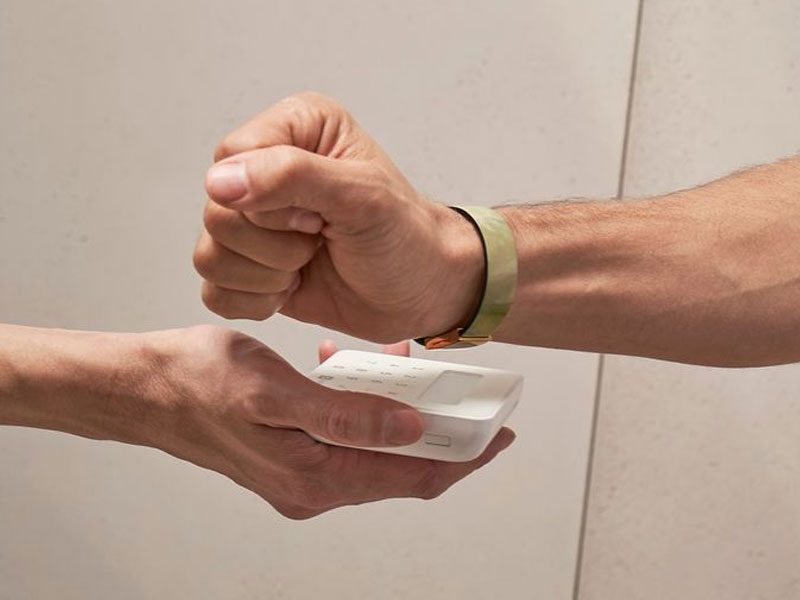Mark Zuckerberg says Meta wearables that read brain signals are coming soon
SOURCE: COINTELEGRAPH.COM
APR 19, 2024
Payment jewelry still has its fans, despite smartwatch dominance
SOURCE: WSJ.COM
SEP 15, 2021

British jeweler Tovi Sorga said sales of its payment accessories have more than doubled in the 12 months ended in August from the year-earlier period.
PHOTO: TOVI SORGA
In September 2015, credit-card issuer Barclaycard and fashion house Lyle & Scott Ltd. unveiled a winter jacket whose wearer could make purchases by tapping the sleeve on contactless payment terminals.
“The world’s first contactless payment jacket,” as the collaboration was described, would promote touch-free technology as “the easiest way to buy everyday things,” a Barclaycard executive said at the time.
Six years later, contactless payment is taking off, driven in part by consumers’ fear of germs during the Covid-19 pandemic. “Payment jackets,” alongside jewelry and other accessories with embedded payment technology, have been eclipsed by a wearable that can do more: the smartwatch.
However, smaller companies that make contactless-payment jewelry say there is still a market for payment devices without a screen or interface, and their wares are selling well.
About 35.3 million wearable payment devices were sold in the first half of 2021, up 34% from a year earlier, according to research firm International Data Corp., or IDC. Of those, 68% were smartwatches, with the rest including devices such as wristbands and ordinary watches that contain contactless-payment technology.
Meanwhile, several big banks have retreated from wearable jewelry and clothing, including U.K.-based Barclays PLC, Barclaycard’s parent. Barclaycard declined to disclose how many of the payment jackets had been sold. Lyle & Scott didn’t respond to a request for comment.
Australia-based Westpac Banking Corp. in July stopped selling its PayWear line of wearable accessories, including wristbands and pins, which it introduced in 2017. The company said it is reviewing its PayWear offering.
“A lot of what came out in 2015, 2016, when wearable technology was a new item on the scene—the rings, the pendants—was kind of like a prototype,” said Ramon Llamas, a research director specializing in wearables at IDC. “The challenge that it ran into was that this was very much a solution in search of a problem.”

PHOTO: CHARLES SYKES/ASSOCIATED PRESS
Visa Inc., which in the 2010s publicized the test of contactless rings, pins and winter gloves under its own brand, said its wearable creations were never destined for mass-market production. The company said it continues to provide contactless technology to businesses that want to embed Visa payments into items such as jewelry.
Some banks are teaming up with makers of contactless-payment jewelry to offer customers wearables without having to build the devices themselves. For example, K Wearables Ltd. has a partnership with ABN Amro Bank NV where customers of the Dutch bank can link a contactless-payment ring to their bank cards.
Rosan Diamond AG, which makes credit cards with inlays of precious and semiprecious stones that can cost tens of thousands of dollars, said its Rosan Pay unit has sold more than 2,000 wearable devices to customers of Belgian bank KBC Group NV through a partnership that started in July 2020. These bracelets, charms and key fobs, in comparison, cost as little as 20.50 euros, equivalent to roughly $24, according to Rosan Diamond, which has offices in Switzerland and Russia.
So-called passive wearables are faster to use than contactless cards because their wearers don’t need to fish out their wallets, proponents say. Another plus is that such wearables, which use technology similar to that of payment cards, don’t need to be charged like phones and watches.
And then there is the question of personal preference—and style.
“I don’t personally want to wear a screen on my wrist, and I think there’s a lot of people who come under that catchment,” said Agnes Davis, director of sales and marketing at U.K.-based Tovi Sorga Ltd., which designs and sells contactless payment bracelets and key fobs.
Makers of payment jewelry describe the devices’ relative simplicity as an asset. Tovi Sorga and Rosan Diamond say they are designers or jewelers first, and technology providers second. Tovi Sorga’s wearables are made from materials such as leather, and designed with luxury tastes in mind.
“We cater for individuality, and it’s really important for us that people come in and feel like they’re in a sweetshop, with a lot to choose from,” said Ms. Davis of Tovi Sorga, which charges £130, equivalent to roughly $180, for its most expensive leather contactless payment bracelet.
Tovi Sorga said its payment-accessories sales more than doubled in the 12 months ended in August from the year-earlier period, but it declined to say how many items it sold.
Ruslan Aybazov, business development director at Rosan Diamond, said the company expects wearable sales to climb even as smartwatches become more sophisticated and smartphones replace more people’s wallets.
The more ubiquitous contactless payments become, the more the market will expand for companies of every size, he said.
“We don’t see Apple Pay, or Samsung Pay, or Google Pay as our competitors,” Mr. Aybazov said. “We actually see it as a supplementary technology, an enhancement to what we offer.”
LATEST NEWS
WHAT'S TRENDING


Data Science
5 Imaginative Data Science Projects That Can Make Your Portfolio Stand Out
OCT 05, 2022

SOURCE: COINTELEGRAPH.COM
APR 19, 2024
SOURCE: HTTPS://INTERESTINGENGINEERING.COM/
NOV 16, 2023
SOURCE: HTTPS://WWW.AZOSENSORS.COM/NEWS
AUG 28, 2023
SOURCE: WWW.WHATGADGET.NET
JUL 11, 2023
SOURCE: HTTPS://WWW.THEHINDU.COM/SCI-TECH/TECHNOLOGY/INDIAS-WEARABLE-MARKET-GREW-47-IN-2022-BOAT-MAINTAINS-LEAD-REPORT/ARTICLE66493121.ECE
JUN 30, 2023